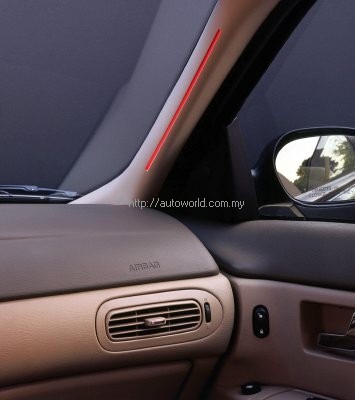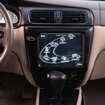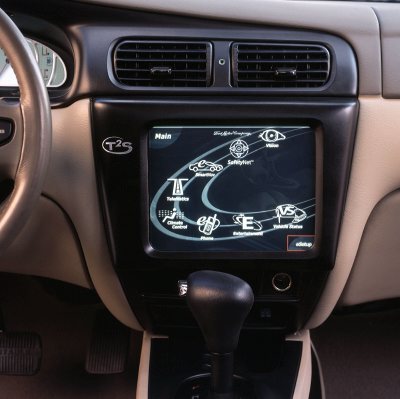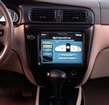Future Fords Will Be Safer
Picture this scenario: you’re driving along the highway at 110 km/h when your infant in the babyseat at the back howls. Stopping is not an option at this time but you want to know what’s happening back there but it is also dangerous to turn around and the rearview mirror can’t adjust to see downwards enough. With the press of a button, a camera beams the image of your upset onto the dashboard in front of you. You see that it is just the milk bottle having fallen to the side… nothing serious.
The child camera is just one of numerous safety and telematics features showcased in the 2003 Ford Taurus Telematics to Safety Concept Car, or ‘T2S’ for short.
Ford’s T2S, currently on display at the 9th World Congress on Intelligent Transport Systems in Chicago, USA, demonstrates some of the groundbreaking safety research currently under development at Ford Motor Company’s Scientific Research Laboratory.
Also being shown is the Ford Windstar T2S concept. This Windstar minivan features a new era of occupant protection and comfort, including advanced software, similar to that used by the military and airline industry, which can help determine the probability of an accident and the desired actions needed to mitigate or even avoid an accident.
These vehicles provide a glimpse of future technologies that one day could help drivers improve safety and security on the road. But for some of these systems, the future is almost here. The all-new 2004 Mercury Monterey minivan, for example, will feature elements of other innovative next-generation technologies, including front and rear object sensing, to further improve the safety of Ford’s vehicles.
One interesting idea is the advance warning system which uses changing colours in the A-pillars to warn the driver of a possible threat situation on the road. A green light signifies all is safe while red – the universal colour for an emergency or danger – implies the forward, rearward, or blind-spot precrash sensing system has determined that a threat is impending.
In addition to the child camera, the T2S concept vehicles are equipped with a suite of pioneering technologies:
– Radar and vision systems allow the vehicle to “see” and estimate the likelihood of potential traffic “threats” and warn the driver;
– A handsfree voice system provides control of the entertainment system, heating and cooling and next-generation telematics.
A next-generation backup camera aid provides enhanced visibility while backing up under varying lighting conditions;
– The rear collision warning system warns the driver of an impending accident and then activates the vehicle’s safety belt pretensioners to optimally position the driver for minimal injury. The oncoming vehicle is alerted by a rear-mounted light strobe system with the goal of avoiding the accident;
– TrafficView side-mounted cameras greatly enhance passenger-side visibility to help alert the driver to pedestrians, bicycles or merging vehicles;
– The lane departure warning system, a low-light forward-facing camera, senses changing road conditions and alerts the driver;
– The NightEye vision system features a low-light colour camera system to warn the driver of possible threats that cannot be seen with the naked eye. Unlike some competitors, Ford uses colour because it is an intuitive, easily understood real-world image;
– Blind spot detection uses radar to warn the driver when a vehicle is detected in a blind spot during a lane-change manoeuvre;
– SmartNAV, a smart navigational system that uses vehicle-to-vehicle communication, as well as incident report information from local municipalities, provides real-time traffic routing;
– SafetyNet enables vehicle-to-vehicle communication. It allows each vehicle to know the location, direction and speed of other vehicles on the road. This information is used to engage the safety belt system and warning system during a crash;
– The digital instrument cluster is reconfigurable and presents information to the driver seamlessly and intuitively. Wireless electronic gaming (Sony PS2) and DVD, along with individual displays in the seatbacks, are used to keep the family entertained on long rides;
– SmartSwitch, a steering wheel mounted switch that performs multiple vehicle functions. The SmartSwitch is mounted on the steering wheel and controls the fan speed and temperature setting for climate control, but becomes the volume, seek and selection control for entertainment, keeping a driver’s hands on the wheel and out of harm’s way.
The Windstar T2S technologies represent a new era of occupant protection and comfort. Coupled to the Windstar concept is a navigation system and advanced sensors that could hold a cellular phone call from ringing in the vehicle if it detects the driver is in a dangerous situation.
Other advanced features will start to roll out in late 2003 with the all-new 2004 Mercury Monterey minivan. The Monterey will be the only minivan in the segment to offer an ultrasonic object-sensing system for the front, in addition to the rear-sensing systems already available on many Ford products. The system uses sensors in the front and rear bumpers to detect objects in front of and behind the vehicle, and assist in gauging distances while parking.
The 2004 Windstar, which also goes on sale next year, will further enhance its long-standing safety reputation of safety leadership by offering side curtain airbags for all three full rows, making it the only minivan on the market to include that safety technology for now.





































